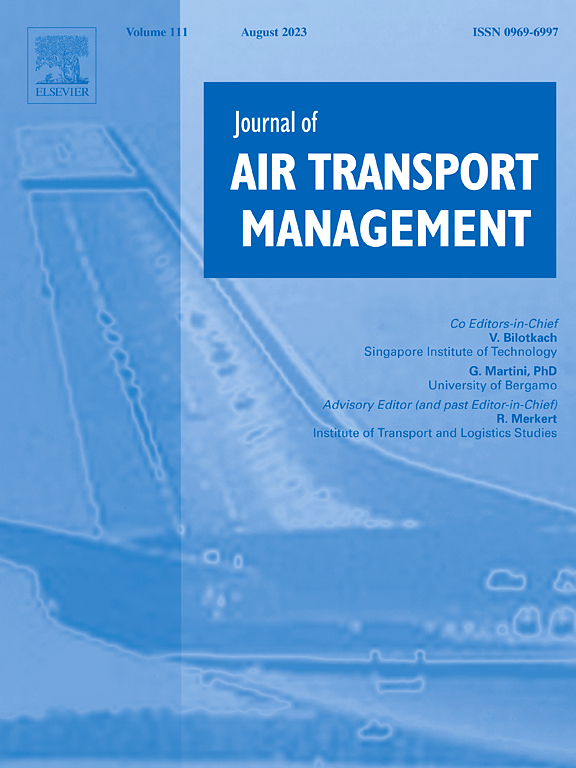Spatial–temporal dynamics of airside congestion: A Macroscopic Fundamental Diagram perspective
IF 3.6
2区 工程技术
Q2 TRANSPORTATION
引用次数: 0
Abstract
Airport airside congestion, driven by the growing imbalance between air traffic demand and constrained capacity, presents significant operational challenges that affect efficiency, safety, and environmental impact. Effectively addressing this requires models that capture the complex interactions within the airside network (taxiways, runways, gates) to provide insights into traffic flow dynamics and mechanisms of congestion formation, spread, and dissipation. Traditional approaches – such as microsimulation methods and queuing models – are often either computationally demanding or focus on specific components (like runways), limiting their ability to capture broader network interactions and reducing their operational feasibility. This study proposes an alternative approach, adapting the Macroscopic Fundamental Diagram (MFD) to model airside traffic using three-dimensional aircraft trajectory data. By analyzing aggregate traffic variables – flow, density, and speed – the MFD provides a computationally efficient means of understanding airside congestion patterns and supports informed decision-making. This paper presents a novel methodology for constructing airside MFDs using A-SMGCS data from Singapore Changi Airport. The study also investigates the spatial and temporal factors contributing to congestion, offering insights into how congestion patterns develop and evolve under varying operational conditions. In the temporal domain, even during low-demand periods, departure and arrival banks contribute to congestion. Additionally, this study analyzes the impact of weather conditions on the airside network flow, highlighting the effects of variable wind and adverse weather, such as rain and thunderstorm, on airside congestion. In the spatial domain, traffic inhomogeneity – an uneven distribution of traffic on the airside network – reduces overall flow, particularly during congestion. These findings highlight the potential to improve airside capacity utilization and mitigate congestion by distributing traffic more evenly across both temporal and spatial domains, i.e., minimizing schedule banks and ensuring a balanced allocation of taxi routes.
空侧拥堵的时空动态:宏观基本图视角
由于空中交通需求和有限容量之间日益不平衡,机场空侧拥堵带来了重大的运营挑战,影响了效率、安全和环境影响。有效地解决这一问题需要模型来捕捉空侧网络(滑行道、跑道、登机口)内复杂的相互作用,以提供对交通流动力学和拥堵形成、传播和消散机制的见解。传统的方法——如微模拟方法和排队模型——通常要么需要计算,要么关注特定的组件(如跑道),限制了它们捕捉更广泛的网络交互的能力,降低了它们的操作可行性。本研究提出了一种替代方法,采用宏观基本图(MFD)利用三维飞机轨迹数据来模拟空侧交通。通过分析综合交通变量——流量、密度和速度——MFD提供了一种计算效率高的方法来理解空侧拥堵模式,并支持明智的决策。本文提出了一种利用新加坡樟宜机场的a - smgcs数据构建空侧mfd的新方法。该研究还调查了导致拥堵的空间和时间因素,为拥堵模式在不同运营条件下的发展和演变提供了见解。在时间域,即使在低需求时期,出发银行和到达银行也会造成拥堵。此外,本研究还分析了天气条件对空侧网络流量的影响,强调了可变风和恶劣天气(如降雨和雷暴)对空侧拥堵的影响。在空间领域,交通的不均匀性——空侧网络上交通的不均匀分布——减少了总体流量,特别是在拥堵期间。这些发现强调了通过在时间和空间领域更均匀地分配交通来提高空侧容量利用率和缓解拥堵的潜力,即最小化时间表银行和确保出租车路线的平衡分配。
本文章由计算机程序翻译,如有差异,请以英文原文为准。
求助全文
约1分钟内获得全文
求助全文
来源期刊

Journal of Air Transport Management
TRANSPORTATION-
CiteScore
12.40
自引率
11.70%
发文量
97
期刊介绍:
The Journal of Air Transport Management (JATM) sets out to address, through high quality research articles and authoritative commentary, the major economic, management and policy issues facing the air transport industry today. It offers practitioners and academics an international and dynamic forum for analysis and discussion of these issues, linking research and practice and stimulating interaction between the two. The refereed papers in the journal cover all the major sectors of the industry (airlines, airports, air traffic management) as well as related areas such as tourism management and logistics. Papers are blind reviewed, normally by two referees, chosen for their specialist knowledge. The journal provides independent, original and rigorous analysis in the areas of: • Policy, regulation and law • Strategy • Operations • Marketing • Economics and finance • Sustainability
 求助内容:
求助内容: 应助结果提醒方式:
应助结果提醒方式:


